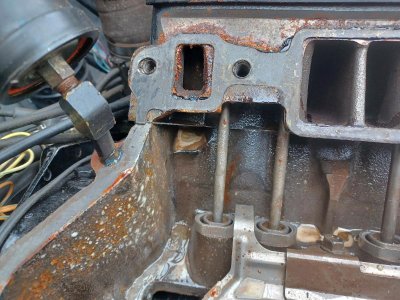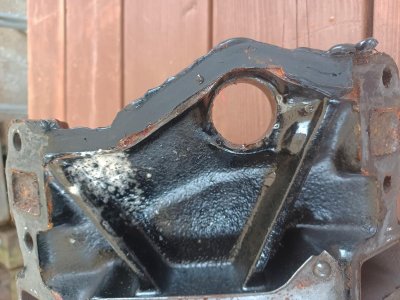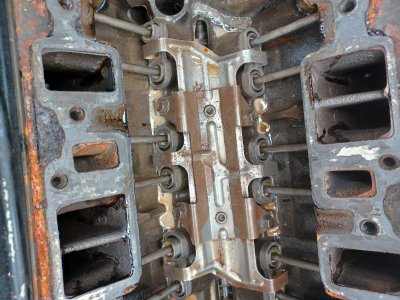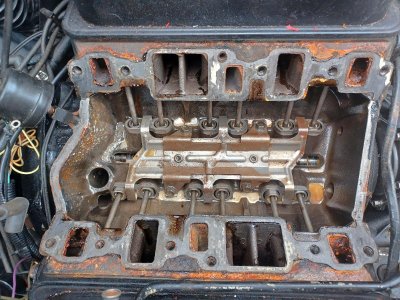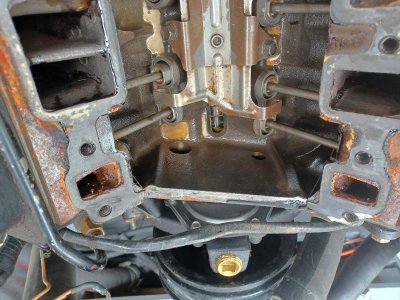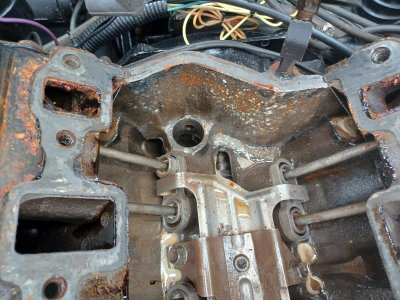dpb
Well-known member
Yesterday was first start of the engine after a full rebuild, started and ran fine. After running for a few minutes stopped it to check things over.
Found that the oil is now mayonnaise so clearly water getting to it.
It is a part of a project boat which serves mainly to keep me busy during retirement so no panic other than I know I need to do something sooner than later to avoid internal damage.
The reason for posting is to pause and see if there are any points that I should be considering before diving in.
How I got to this point:
I acquired the engine with seized pistons and valve and head damage. It came with manifold and risers off and new ones supplied, all looking like corrosion in bores and valves caused by exhaust component failure.
The engine was taken apart and was rebuilt with the following:
Crank reground with appropiate new bearings used.
New pistons, rings fitted.
Block rebored for new pistons. (carried out by engineering company)
Reconditioned heads complete with new valves etc fitted. (Bought from specialist)
I realise now that somewhat stupidly I did not check the block specifically for cracks but then I did not discover anything during the dismantle to point in that direction, in particular no emmulsified oil residue anywhere.
Anyway, I have removed the emulsified oil as much as I can for now, the level on the dipstick had gone up by 30 to 50mm.
Also the water has been drained. During that process I noticed that very little water came out of the right bank, which I drained first, but plenty out of the other bank. Poking around the drain hole with no flow did not seem to show a blockage. Is the water jacket on either side of the block separate? I thought it was all one joined up chamber.
So now I am thinking that the cause could be:
Cracked block. maybe at the bottom of the side of the block that did not drain.
Cracked cylinder head ie faulty from purchase
Cracked inlet manifold
Bad gasket joints, at cylinder head or inlet manifold
I am currently discounting exhaust failure as it was all new and I dont think the symptoms fit this cause.
Most of the rebuild was done 2 years ago so the engine has been sat in the garage for a while.
The engine has been sat in the boat over winter with tarp over it so rainwater could have got to it but surely the only way in is via the carb and that was sealed
My current plan is to remove inlet manifold and heads to see whats what and to allow oil to be poured over essential parts.
Wondering if worth doing compression tests, or turning the engine on the starter with fresh oil before dismantling.
May only do mimimal work now and address the situation next winter as we are away most of the summer.
I could fill the block after manifold and head removal with cheapo oil or even diesel to preserve the parts over the summer.
Any thoughts?... What have I missed?
Found that the oil is now mayonnaise so clearly water getting to it.
It is a part of a project boat which serves mainly to keep me busy during retirement so no panic other than I know I need to do something sooner than later to avoid internal damage.
The reason for posting is to pause and see if there are any points that I should be considering before diving in.
How I got to this point:
I acquired the engine with seized pistons and valve and head damage. It came with manifold and risers off and new ones supplied, all looking like corrosion in bores and valves caused by exhaust component failure.
The engine was taken apart and was rebuilt with the following:
Crank reground with appropiate new bearings used.
New pistons, rings fitted.
Block rebored for new pistons. (carried out by engineering company)
Reconditioned heads complete with new valves etc fitted. (Bought from specialist)
I realise now that somewhat stupidly I did not check the block specifically for cracks but then I did not discover anything during the dismantle to point in that direction, in particular no emmulsified oil residue anywhere.
Anyway, I have removed the emulsified oil as much as I can for now, the level on the dipstick had gone up by 30 to 50mm.
Also the water has been drained. During that process I noticed that very little water came out of the right bank, which I drained first, but plenty out of the other bank. Poking around the drain hole with no flow did not seem to show a blockage. Is the water jacket on either side of the block separate? I thought it was all one joined up chamber.
So now I am thinking that the cause could be:
Cracked block. maybe at the bottom of the side of the block that did not drain.
Cracked cylinder head ie faulty from purchase
Cracked inlet manifold
Bad gasket joints, at cylinder head or inlet manifold
I am currently discounting exhaust failure as it was all new and I dont think the symptoms fit this cause.
Most of the rebuild was done 2 years ago so the engine has been sat in the garage for a while.
The engine has been sat in the boat over winter with tarp over it so rainwater could have got to it but surely the only way in is via the carb and that was sealed
My current plan is to remove inlet manifold and heads to see whats what and to allow oil to be poured over essential parts.
Wondering if worth doing compression tests, or turning the engine on the starter with fresh oil before dismantling.
May only do mimimal work now and address the situation next winter as we are away most of the summer.
I could fill the block after manifold and head removal with cheapo oil or even diesel to preserve the parts over the summer.
Any thoughts?... What have I missed?

